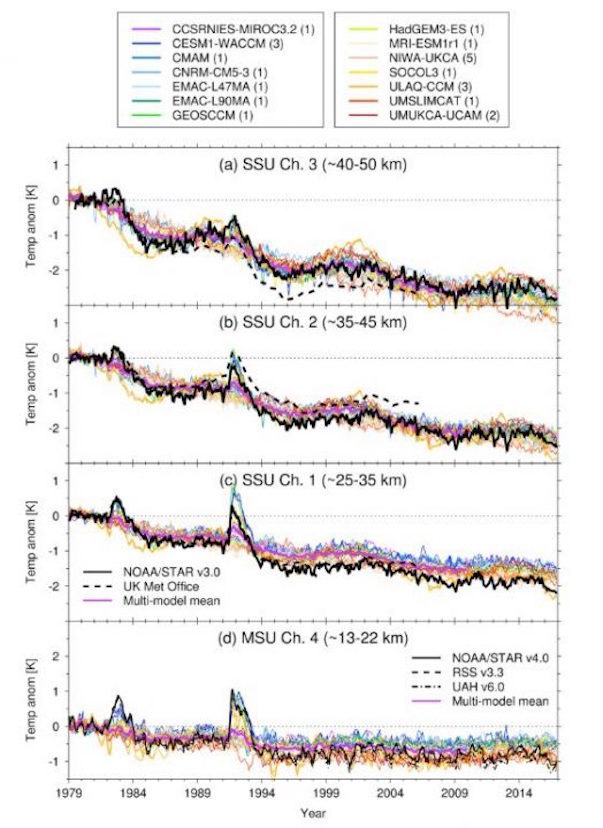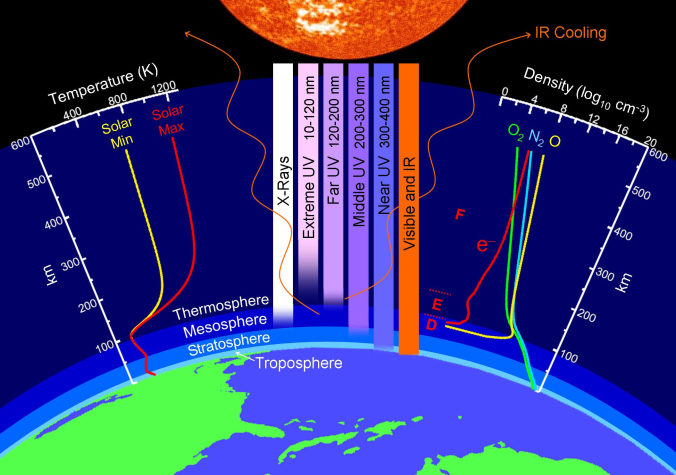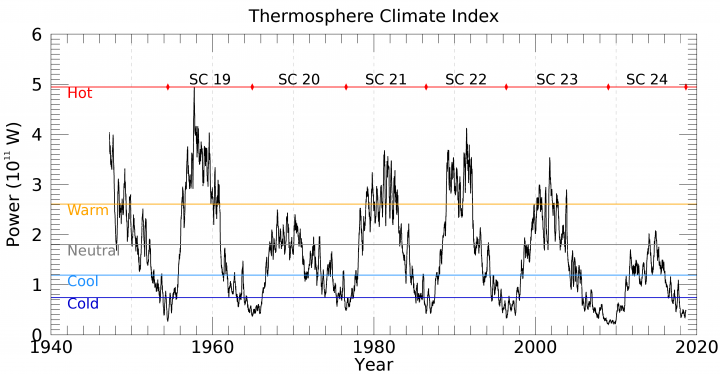
Of course, the authors, being biased towards the universal boogeyman of CO2, had only one thing on their minds. But a recent essay by Dr. Tony Phillips suggests the lower solar activity has cooled the thermosphere, which could in turn aid the cooling of the stratosphere:
From the plain language description of the publication:
A previous analysis by Thompson et al. (2012, https://doi.org/10.1038/nature11579) showed substantial differences between satellite‐observed and model‐simulated stratospheric cooling trends since the late 1970s. Here we compare recently revised and extended satellite temperature records with new simulations from 14 chemistry‐climate models. The results show much better agreement in the magnitude of stratospheric cooling over 1979-2005 between models and observations. This cooling was predominantly driven by increasing greenhouse gases and declining stratospheric ozone levels. An extended satellite temperature record and the chemistry‐climate models show weaker global stratospheric cooling over 1998-2016 compared to 1979-1997. This is due to the reduction in ozone‐induced cooling from the slowdown of ozone trends and the onset of ozone recovery since the late 1990s. There are larger differences in the latitudinal structure of past stratospheric temperature trends due to the effects of unforced atmospheric variability. In summary, the results show much better consistency between simulated and satellite‐observed stratospheric temperature trends than was reported by Thompson et al. (2012, https://doi.org/10.1038/nature11579) for the previous versions of the satellite record and last generation of chemistry‐climate models. The improved agreement mainly comes from updates to the satellite records, while the range of simulated trends is comparable to the previous generation of models.
The paper: Revisiting the Mystery of Recent Stratospheric Temperature Trends
Open access PDF here.
Abstract
Simulated stratospheric temperatures over the period 1979-2016 in models from the Chemistry‐Climate Model Initiative are compared with recently updated and extended satellite data sets. The multimodel mean global temperature trends over 1979-2005 are −0.88 ± 0.23, −0.70 ± 0.16, and −0.50 ± 0.12 K/decade for the Stratospheric Sounding Unit (SSU) channels 3 (~40-50 km), 2 (~35-45 km), and 1 (~25-35 km), respectively (with 95% confidence intervals). These are within the uncertainty bounds of the observed temperature trends from two reprocessed SSU data sets. In the lower stratosphere, the multimodel mean trend in global temperature for the Microwave Sounding Unit channel 4 (~13-22 km) is −0.25 ± 0.12 K/decade over 1979-2005, consistent with observed estimates from three versions of this satellite record. The models and an extended satellite data set comprised of SSU with the Advanced Microwave Sounding Unit‐A show weaker global stratospheric cooling over 1998-2016 compared to the period of intensive ozone depletion (1979-1997). This is due to the reduction in ozone‐induced cooling from the slowdown of ozone trends and the onset of ozone recovery since the late 1990s. In summary, the results show much better consistency between simulated and satellite‐observed stratospheric temperature trends than was reported by Thompson et al. (2012, https://doi.org/10.1038/nature11579) for the previous versions of the SSU record and chemistry‐climate models. The improved agreement mainly comes from updates to the satellite records; the range of stratospheric temperature trends over 1979-2005 simulated in Chemistry‐Climate Model Initiative models is comparable to the previous generation of chemistry‐climate models.





Comment: See also: Temperatures have dropped to -91°C (-131,8°F) in the stratosphere!